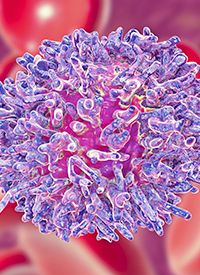Article
Frontline Ibrutinib Shows Sustained Survival Benefit in TP53-Aberrant CLL
Author(s):
Ibrutinib as a frontline treatment led to sustained efficacy and impressive 4-year progression-free and overall survival rates in patients with chronic lymphocytic leukemia who have TP53 aberrations.
Chronic lymphocytic leukemia

Ibrutinib (Imbruvica) as a frontline treatment led to sustained efficacy and impressive 4-year progression-free and overall survival (OS) rates in patients with chronic lymphocytic leukemia (CLL) who have TP53 aberrations, according to a pooled analysis of 4 trials.
At a median follow-up of 4 years (range, <1-8 years), the 4-year progression-free survival (PFS) rate was 79% and the 4-year OS rate was 88%. Additionally, no new safety signals with ibrutinib were identified with the longer follow-up, and the rate of grade 3 or higher adverse effects (AEs) of clinical interest declined following the first year of therapy with ibrutinib.
“Although patients with TP53 aberrations remain at risk for progression, first-line treatment with ibrutinib has meaningfully improved the poor prognosis in this high-risk population,” Inhye E. Ahn, MD, of the National Heart, Long, and Blood Institute, and co-investigators, wrote in the poster that was presented during the 25th Annual International Congress on Hematologic Malignancies.
TP53 mutations are generally a strong prognostic factor of patients with CLL as it relates to disease progression and OS outcomes. The presence of this abnormality often leads to inferior outcomes with chemoimmunotherapy vs those without these aberrations.
Ibrutinib is currently approved by the FDA for the treatment of patients with CLL/small lymphocytic lymphoma, including those with a 17p deletion (del[17p]), as a monotherapy or in combination with rituximab (Rituxan) or obinutuzumab (Gazyva), or in combination with bendamustine and rituximab.
In the pooled analysis of four phase 2 and phase 3 studies (n = 89), investigators sought to evaluate the long-term efficacy and safety of frontline ibrutinib-based treatment in patients with TP53-mutant CLL. The studies that were examined included: the phase 2 PCYC-1122e (NCT01500733) study of ibrutinib alone in del(17p)/TP53-mutant CLL, the phase 3 RESONATE-2 (NCT01722487) trial of ibrutinib alone in TP53-mutant CLL, the phase 3 iLLUMINATE (NCT02264574) study of ibrutinib/obinutuzumab in del(17p)/TP53-mutant CLL, and the phase 3 ECOG1912 (NCT02048813) trial of ibrutinib plus rituximab in patients with TP53-mutant CLL.
PFS, OS, objective response rate (ORR), complete response (CR) rate, and safety were all investigator-assessed outcomes. While PFS and OS were estimated via the Kaplan-Meier method, ORR was measured via 2008 International Workshop on Chronic Lymphocytic Leukemia guidelines.
The median age of all patients was 65 years (range, 33-87) and 69% of patients were male. More than half (53%) had Rai stage III/IV disease, and 38% of patients had bulky disease. The median lactate dehydrogenase level was 233 U/L (range, 52-2568), and 69% of patients had unmutated IGHV disease. Ninety-one percent of patients had a TP53 mutation, and 53% harbored del(17p). Among 16 patients with del(17p) who also had TP53 sequencing data available, 11 patients had both del(17p) and a TP53 mutation.
The median follow-up for all patients was 50 months (range, 0.1-95.9). Fifty-one percent of patients received ibrutinib monotherapy, while the rest received it in combination with an anti-CD20 antibody. The median duration of ibrutinib treatment was 46 months (range, 0.1-95.5); reasons for discontinuation included disease progression (20%), study closure (11%), AEs (10%), patient withdrawal (7%), death (3%), and investigator decision (2%). Forty-six percent of patients remained on ibrutinib therapy at the time of the analysis.
Three of the patients who discontinued due to disease progression had both del(17p) and TP53 mutations; 4 of these patients had only TP53 mutations. The remaining 11 patients had del(17p) alone, but their TP53 mutation data were unavailable.
Additional findings showed that the median PFS was not reached (95% CI, 67 months to not estimable [NE]). In the 47 patients who had del(17p) or a TP53 mutation, the median PFS was not reached (95% CI, 60–NE). In those who harbored both del(17p) and TP53 mutations, the median PFS was 42.8 months (95% CI, 7–NE). Most patients (83%) achieved a response to treatment, which elicited a 94% ORR and a 39% CR rate.
Eighteen patients (20%) had a secondary malignancy, which was most commonly non-melanoma skin cancer (n = 12; 13.5%), followed by melanoma (n = 2), prostate cancer (n = 2), plasma cell myeloma (n = 1), and unknown/neoplasmtype not specified (n = 4).
The most common subsequent treatment that was initiated following ibrutinib due to disease progression was venetoclax (Venclexta)-based therapy (n = 9), a PI3K inhibitor (n = 2), acalabrutinib (Calquence; n = 1), and chemoimmunotherapy (n = 5).
Sixty-three patients had data available for Richter’s transformation (RT), and 2 transformations were reported; the times to transformation were 0.4 months and 15.2 months. No patients on RESONATE-2 and iLLUMINATE progressed due to RT, and RT data were unavailable for ECOG1912 at the time of the analysis.
Regarding safety, AEs that led to ibrutinib discontinuation were atrial fibrillation (n = 2), and anemia, hemoptysis, platelet count decrease, pneumonia, rash, septic shock, and death (n = 1 each). At a median follow-up of 10 months following ibrutinib discontinuation due to an AE, 2 patients died due to an AE; 1 patient had progressive disease. The time to progression in the latter patient was 3 years.
Reference
- Ahn IE, Shanafelt T, Wiestner A, et al. Long-term efficacy of first-line (1L) ibrutinib (Ibr) treatment after 4 years of follow-up in patients (pts) with TP53 aberrant chronic lymphocytic leukemia (CLL): a pooled analysis of 4 trials. Presented at: 25th Annual International Congress on Hematologic Malignancies; February 24-27, 2021; virtual. Abstract 9.






%20(2)%201-Recovered-Recovered-Recovered-Recovered-Recovered.jpg?fit=crop&auto=format)

%20(2)%201-Recovered-Recovered-Recovered-Recovered-Recovered.jpg?fit=crop&auto=format)
%20(2)%201-Recovered-Recovered-Recovered-Recovered-Recovered.jpg?fit=crop&auto=format)